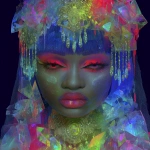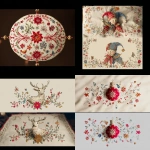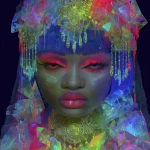Explore the Best AI Image Gallery

Beyond the Canvas: 5G and the Transformative Power of Wearable Tech in the Creative Industry
The convergence of 5G technology and wearable devices marks a pivotal moment in the evolution of the creative industry. This powerful synergy is not merely enhancing existing practices but fundamentally reshaping how we conceive, create, and experience art, design, and entertainment.
5Gs ultra-fast speeds, low latency, and massive connectivity capabilities are unlocking unprecedented possibilities for wearable tech, empowering artists and creators with real-time collaboration tools, immersive sensory experiences, and the ability to bridge the gap between the physical and digital realms.
A New Era of Creative Expression
The creative canvas is expanding beyond traditional mediums. Wearable technology, now infused with 5Gs power, is enabling artists to:
- Interactive Installations: Imagine a sculpture that reacts to viewers movements, or a painting that evolves in real time based on surrounding soundscapes. 5G-enabled wearables can create interactive experiences that blur the lines between art and viewer participation.
- Personalized Storytelling: Wearable devices equipped with sensors can capture biometric data like heart rate, movement, and even emotional cues. Artists can then use this data to personalize narratives, creating immersive stories tailored to individual viewers responses.
- Augmented Reality (AR) Design: Architects and designers can utilize AR through wearables to visualize their creations in real-world environments, making adjustments on the fly and collaborating with clients seamlessly.
Empowering Collaboration and Accessibility
5G is also revolutionizing collaboration within the creative industry. Real-time communication and file sharing facilitated by 5G networks enable:
- Remote Teams: Artists, designers, musicians, and developers can collaborate effectively from any location, breaking down geographical barriers and fostering global creativity.
- Inclusive Design: Wearable technology can empower individuals with disabilities to participate more fully in creative processes. For example, haptic feedback devices can allow visually impaired artists to feel their creations or navigate virtual environments.
Navigating Ethical Considerations
As 5G and wearable tech continue to evolve, it is crucial to address the ethical considerations that arise:
- Data Privacy: Wearable devices collect vast amounts of personal data. Its essential to ensure robust privacy safeguards and transparent data usage policies.
- Algorithmic Bias: AI algorithms used in creative applications can perpetuate existing societal biases. Its important to develop ethical frameworks and promote diversity in the development of these technologies.
- Accessibility Gap: Not everyone has equal access to 5G networks and wearable technology. Addressing this digital divide is crucial to ensure inclusive creativity.
Future Trends Shaping the Creative Landscape
The convergence of 5G and wearable tech is a dynamic field with exciting future trends:
- Brain-Computer Interfaces (BCIs): Imagine translating thoughts directly into creative outputs, such as music or art. BCIs have the potential to revolutionize artistic expression.
- Metaverse Experiences: Wearables will play a central role in immersive metaverse environments, enabling creators to build interactive worlds and experiences that transcend physical limitations.
- Personalized Creative Tools: AI-powered wearable tools will adapt to individual creative styles, offering personalized recommendations, suggestions, and assistance throughout the creative process.
The future of creativity is being rewritten by 5G and wearable technology. As these technologies continue to evolve, we can anticipate a world where artistic expression is more inclusive, immersive, and interconnected than ever before.

](https://images.ai-img.art/thumbnails/150/60973df1d727dbbf8e6922b7e4836814ab6012106eb9dcfe99aea7aec15f3710.webp)






](https://images.ai-img.art/thumbnails/150/6c909fd6d38caac6572b592dd97831deb7d6562bba142798574677582676dfc1.webp)







](https://images.ai-img.art/thumbnails/150/184b4b030e30be0a6d51b544226cb4cf2271977814d935d3aaa2b7529355b3b7.webp)












](https://images.ai-img.art/thumbnails/150/26c16e4f635deee86633de398088ca98d9bb748d6e7601436b07e882fab236cb.webp)









](https://images.ai-img.art/thumbnails/150/655229c40961cb7ff5abd4b4190e02c94ea1a961106e7547a562649c945268be.webp)

](https://images.ai-img.art/thumbnails/150/e6a179db327f0374ec327d0fdab48ac1f2dc47123eed103b0a41ed346280d07d.webp)







](https://images.ai-img.art/thumbnails/150/1202074d0d60b08b64d0f91f36468608aaac200a02b721cc8e6d8ec8a908432c.webp)